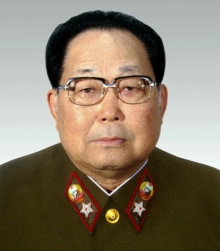
Kim Jong Il was a North Korean politician who was the second supreme leader of North Korea. He led North Korea from the death of his father Kim Il Sung in 1994 until his own death in 2011, when he was succeeded by his son, Kim Jong Un. Afterwards, Kim Jong Il was declared Eternal General Secretary of the WPK.

The Korean diaspora consists of around 7.3 million people, both descendants of early emigrants from the Korean Peninsula, as well as more recent emigrants from Korea. Around 84.5% of overseas Koreans live in just five countries: China, the United States, Japan, Canada, and Uzbekistan. Other countries with greater than 0.5% Korean minorities include Brazil, Russia, Kazakhstan, Vietnam, the Philippines, and Indonesia. All these figures include both permanent migrants and sojourners.

Vyatskoye is a small fishing village in Khabarovsky District, Khabarovsk Krai, Russia, located on the east side of the Amur River, 70 kilometers (43 mi) northeast of Khabarovsk. The 76th Radio Technical Brigade is stationed there.
Koryo-saram or Koryoin are ethnic Koreans in the post-Soviet states who descend from Koreans who were living in the Russian Far East.

Kim Ok is a former North Korean government employee who served as Kim Jong Il's personal secretary from the 1980s until his death. After the death of Ko Yong-hui in August 2004, she regularly met with foreign officials as de facto first lady, and was rumored to be the supreme leader's fourth wife.

Sakhalin Koreans are Russian citizens and residents of Korean descent living on Sakhalin Island, who can trace their roots to the immigrants from the Gyeongsang and Jeolla provinces of Korea during the late 1930s and early 1940s, the latter half of the Japanese ruling era.
The Kippumjo, sometimes spelled Kippeumjo, is an unconfirmed collection of groups of approximately 2,000 women and girls reportedly maintained by the leader of North Korea for the purpose of providing entertainment, including that of a sexual nature, for high-ranking Workers' Party of Korea (WPK) officials and their families, as well as, occasionally, distinguished guests.

Kim Yong-chun was a North Korean soldier and politician. He was a leader of the North Korean military. He held the North Korean military rank Chasu, was Vice Chairman of the National Defense Commission of North Korea, and was Minister of People's Armed Forces. He held a minor post within the Workers Party.

Japanese people in Russia form a small part of the worldwide community of Nikkeijin, consisting mainly of Japanese expatriates and their descendants born in Russia. They count various notable political figures among their number.
Japanese people in North Korea are people of Japanese descent living in North Korea. They consist mainly of four groups: prisoners-of-war in the Soviet Union, Japanese accompanying repatriating Zainichi Korean spouses, defectors, and kidnapping victims. The number who remain alive is not known.
Vietnamese people in Korea, also known as Vietnamese Koreans, have a history dating back to the 12th century. After the division of Korea and the Korean War, ethnic Vietnamese had various contacts with both North and South Korea. They are Vietnamese expatriates in Korean peninsular or Korean born-citizens were born of partially or full Vietnamese descent. In the latter, Vietnamese are the second-largest group of foreigners, after Chinese migrants.
Russians in Korea do not form a very large population, but they have a history going back to the Korean Empire. The community of Russian subjects/citizens in Korea has historically included not just ethnic Russians, but members of minority groups of Russia as well, such as Tatars, Poles, and, more recently, return migrants from among the Koryo-saram and Sakhalin Koreans.
Room 39 is a secretive North Korean party organization that seeks ways to maintain the foreign currency slush fund for the country's leaders.

Okryu-gwan or Okryu Restaurant is a restaurant in Pyongyang, North Korea, founded in 1960. South Korea analyst Andrei Lankov describes it as one of two restaurants, the other being Ch'ongryugwan, which have "defined the culinary life of Pyongyang" since the 1980s, and a "living museum of culinary art".

Vice Marshal Ri Yong-ho was a North Korean military officer who was Chief of the General Staff of the Korean People's Army from 2009 to 2012, as well as a member of the Presidium of the Workers' Party of Korea from September 2010 to July 2012.
Kim Man-il was the second son of the North Korean founding leader Kim Il Sung and his first wife Kim Jong-suk. He was the younger brother of Kim Jong Il, the second leader of North Korea.

Choe Ryong-hae is a North Korean politician and military officer who currently serves as Chairman of the Standing Committee of the Supreme People's Assembly and First Vice President of the State Affairs Commission, holding both positions since April 2019. Due to holding the first office, he was considered the head of state of North Korea before the country's constitution was amended to transfer this position to the President of the State Affairs Commission, Kim Jong Un. He is also a member of the Presidium of the Politburo and Vice Chairman of the Workers' Party of Korea (WPK). He also served as Supreme Leader Kim Jong Un's military second-in-command, currently being third top-ranking official in North Korea after Kim Jong Un and premier Kim Tok-hun.

Ri Ul-sol was a North Korean politician and military official. He played an important role in the administrations of Kim Il Sung and Kim Jong Il, achieving the rank of marshal of the Korean People's Army. He was responsible for the safety of top North Korean leaders and their families as Commander of the Guard.
Pyon In-son is North Korean politician and military officer, colonel general and from March 2012 commander of the 4th Corps of the Korean People's Army.













